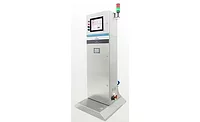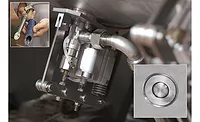Engineering R&D
Rubber Fab develops technology to spot rubber with x-rays
Sanitary gaskets and seals have typically been invisible to X-ray detection systems, but a new range of functional materials makes them opaque

Stephen Doherty, Rubber Fab
Photos courtesy of Rubber Fab

Already known as the innovator behind the original metal-detectable gasket, Rubber Fab, acquired by Garlock Hygienic Technologies in 2016, has solved another perennial problem—how to detect rubber seal and gasket foreign matter in food using X-ray systems, as X-rays just don’t generally see rubber or fluoropolymer sealing materials.
Rubber Fab’s US patent for X-ray opaque polymeric materials is part of the company’s Detectomer portfolio, which includes a full range of metal detectable and X-ray inspectable sanitary gaskets and O-rings. These products allow food and beverage processors to reduce their risks through better detection of non-metallic contaminants.
With an increasing number of product recalls in 2017 due to foreign matter found in consumer food products, many processors have stepped up end-of-line inspections to include vision, metal detection and X-ray systems, hoping the combination would spot contamination problems. But without making plastic or rubber parts visible to these systems, foreign bodies can still get through.
FE spoke with Stephen Doherty, Rubber Fab global director of business development, to fill in some details.
FE: To make “invisible” materials visible to metal detection systems, suppliers have embedded metal particles in the plastic. What are the issues with elastomers like rubber seals, gaskets and O-rings?
Stephen Doherty: Well it’s pretty much the same issue, with most contamination events occurring as a result of operator error (i.e., somebody accidentally dropping a component into the system during installation or maintenance) or as a result of incorrect material selection. By this, I mean that many times the wrong elastomer or polymer is specified for the application, which is not fully compatible with the process conditions. Incompatibility of gaskets and O-rings (e.g., due to excess temperatures, pressures or chemical effects from process and cleaning media) typically results in physical degradation of soft components, with fragments and particles entering the process stream. Almost all of the gasket failures that we encounter in the field are caused by incorrect specification.
FE: Why use X-ray detection with elastomers instead of metal detection technologies?
Doherty: There is no such thing as a silver bullet when it comes to detection of foreign body contaminants in the food processing industry. Metal detection has some great characteristics as a detection technique and has been used with good success for many years, but it has many drawbacks: line speed, aperture size, distance from the contaminant, orientation of contaminant, interference from wet and fatty foods … all play a significant (and additive) role in the ability to detect particles.
X-ray detection techniques overcome many of these issues and also enable inspection of packaged goods, which presents the final—and indeed most critical—point of inspection before the goods leave the factory and enter the retail and consumer supply chain. The ability to detect non-metallic contaminants inside both metallic and non-metallic packaging is probably the best opportunity to … significantly reduce product recalls.
FE: How do you make elastomers visible to X-ray systems? What materials/additives are used?
Doherty: As with all of our products, the exact formulation is proprietary and is heavily protected as part of our intellectual property. However, the additives that we use are based on the same chemistry that is used in the healthcare industry to provide enhanced opacity and image resolution for patients undergoing medical scans. So, if you can imagine taking a barium sulfate drink before having an intestinal X-ray, then our technology does exactly the same thing.
FE: Are these additives food safe? Can they leach out in highly acidic foods/beverages, edible oils/fats, etc.?
Doherty: All of the additives and components that we use for our food-grade materials are classified as GRAS (generally regarded as safe). We also carry out full testing of the finished material and product to ensure that extractables and leachables are within the limits defined by industry bodies and government regulators. There is absolutely no point adding functionality to a material if that reduces or eliminates its relevance (and compliance) within highly regulated industries, such as food, beverage and pharmaceutical processing.
FE: What food safety compliance specifications do the additives meet?
Doherty: The full range of Detectomer materials are all FDA compliant, according to Title 21 CFR 177.2600 and 177.1550. They are also certified to 3-A Sanitary Standards, are free of ADIs (animal derived ingredients) and also avoid the use of phthalates within the formulation.
FE: How much more visible does the additive make elastomers to X-ray systems?
Doherty: With comprehensive benchmark testing carried out during development of the technology, we typically observed >100 percent increase in opacity, which means that the normally invisible contaminants became immediately identifiable. However, visibility of contaminants under X-ray inspection is still somewhat subjective, and there does not yet exist a common set of standards. Even though X-ray detection is a mature (but evolving) technology, its adoption within the food processing industry is still very much in the early stages. Therefore, I believe there is an opportunity for key stakeholders across several peer groups to work more closely to define testing methods and references. As we accelerate the adoption of Detectomer materials across the Rubber Fab and Garlock portfolios, we are now collaborating with some of the global leaders in X-ray detection equipment to further develop our understanding at both component and system level.
FE: Will Rubber Fab have a catalog/cross reference to replace treated elastomers in machines?
Doherty: We already provide a full catalog, as well as compliance documentation for the entire range, and have been doing so for a number of years. Even before the patent was granted toward the end of 2017, Rubber Fab had been supplying Detectomer gaskets and O-rings as a unique solution to the food processing industry, so this provided valuable customer feedback and allowed us to get a head start on documentation. Like-for-like replacements are available for all common elastomers and fluoropolymers.
FE: How much does the additive treatment increase the cost of a part?
Doherty: The finished Detectomer parts are indeed more expensive than standard elastomers in terms of dollars per unit, and this can be a few orders of magnitude higher depending on the specific product. However, the associated investment in detection equipment should always be evaluated in terms of value rather than cost. Many of our customers are major food processing companies that already encounter the heavy burden and cost of product recalls and are determined to avoid further immediate financial impact, as well as long-term damage to their reputation and brand.
Looking for a reprint of this article?
From high-res PDFs to custom plaques, order your copy today!








